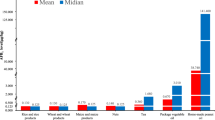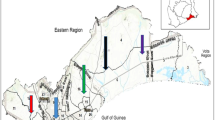Abstract
Background
Aflatoxins are mycotoxins produced by naturally occurring fungi on food, and aflatoxin B1 (AFB1) is carcinogenic, immunotoxic and hepatotoxic. This study assesses the relationship between AFB1 in Nepali infants at 12 months of age and their diet at 9 and 12 months of age.
Methods
The study used data collected from 1329 infants enrolled in the AflaCohort Study. Aflatoxin exposure was assessed at 12 months using serum AFB1-lysine pg/mg albumin biomarker measured using high performance liquid chromatography-fluorescent detection. Dietary data were collected using food frequency questionnaire. We conducted ordinary least squares and quantile regression analyses with backward elimination to assess lagged (9-month diet and 12-month AFB1) and contemporaneous (12-month diet and 12-month AFB1) associations.
Results
Eighty-one percent of children at 12 months had detectable levels of serum AFB1-lysine (geometric mean: 0.79 pg/mg albumin, 95% CI: 0.74–0.83). The levels ranged from 0.4 to 85 pg/mg albumin. Dietary diversity at 9 and 12 months were not associated with serum AFB1-lysine levels. Consumption of fish and groundnuts at both 9 and 12 months and infant formula and cauliflower at 9 months were associated with higher serum AFB1-lysine while consumption of bananas and mangoes at 12 months were negatively associated with serum AFB1-lysine (p < 0.05).
Conclusions
High prevalence of detectable AFB1-lysine among infants, and possible links to their dietary patterns argues for more urgent research into which foods in children’s diets are most contaminated, and into optimal entry points in the food chain that would allow for effective actions to minimize exposure.
This is a preview of subscription content, access via your institution
Access options
Subscribe to this journal
Receive 12 print issues and online access
$259.00 per year
only $21.58 per issue
Buy this article
- Purchase on Springer Link
- Instant access to full article PDF
Prices may be subject to local taxes which are calculated during checkout


Similar content being viewed by others
Data availability
Data described in the manuscript, codebook, and analytic code will be made available upon request pending approval. Data will be made publicly and freely available without restriction at https://data.usaid.gov/ once all manuscripts related to the study’s original research questions have been published in peer-reviewed journals.
References
International Agency for Research on Cancer. IARC monographs on the evaluation of carcinogenic risks to humans, vol 56, Chemical agents and related occupations. 2012;100F:1–599.
Anttila A, Bhat RV, Bond JA, Borghoff SJ, Bosch FX, Carlson GP, et al. IARC monographs on the evaluation of carcinogenic risks to humans: some traditional herbal medicines, some mycotoxins, naphthalene and styrene. IARC Monographs on the Evaluation of Carcinogenic Risks to Humans. 2002;82.
Shouman BO, El Morsi D, Shabaan S, Abdel-Hamid AH, Mehrim A. Aflatoxin B1 level in relation to child’s feeding and growth. Indian J Pediatrics. 2012;79:56–61.
Gong YY, Cardwell K, Hounsa A, Egal S, Turner P, Hall A, et al. Dietary aflatoxin exposure and impaired growth in young children from Benin and Togo: cross sectional study. BMJ. 2002;325:20–1.
Turner PC, Moore SE, Hall AJ, Prentice AM, Wild CP. Modification of immune function through exposure to dietary aflatoxin in Gambian children. Environ Health Perspect. 2003;111:217–20.
Mahdavi R, Nikniaz L, Arefhosseini SR, Jabbari MV. Determination of Aflatoxin M 1 in breast milk samples in Tabriz–Iran. Matern child health J. 2010;14:141.
Mahfuz M, Alam MA, Fahim SM, Gazi MA, Raihan MJ, Hossain M, et al. Aflatoxin exposure in children living in Mirpur, Dhaka: data from MAL-ED companion study. J Expo Sci Environ Epidemiol. 2018;29:655–62.
Lauer JM, Duggan CP, Ausman LM, Griffiths JK, Webb P, Wang J, et al. Maternal aflatoxin exposure during pregnancy and adverse birth outcomes in Uganda. Matern child Nutr. 2019;15:e12701.
Andrews-Trevino JY, Webb P, Shively G, Rogers BL, Baral K, Davis D, et al. Relatively low maternal aflatoxin exposure is associated with small-for-gestational-age but not with other birth outcomes in a prospective birth cohort study of Nepalese infants. J Nutr. 2019;149:1818–25.
Strosnider H, Azziz-Baumgartner E, Banziger M, Bhat RV, Breiman R, Brune M-N, et al. Workgroup report: public health strategies for reducing aflatoxin exposure in developing countries. Environ Health Perspect. 2006;114:1898.
IARC. IARC monographs on the evaluation of carcinogenic risks to humans, some naturally occurring substances: food items and constituents, heterocyclic aromatic amines and mycotoxins. 1993;56.
Iqbal SZ, Asi MR, Hanif U, Zuber M, Jinap S. The presence of aflatoxins and ochratoxin A in rice and rice products; and evaluation of dietary intake. Food Chem. 2016;210:135–40.
Prandini A, Tansini GI, Sigolo S, Filippi LA, Laporta M, Piva GI. On the occurrence of aflatoxin M1 in milk and dairy products. Food Chem Toxicol. 2009;47:984–91.
Akter A, Rahman M, Hasan M. Effects of Aflatoxin B1 on growth and bioaccumulation in common carp fingerling in Bangladesh. Asia-Pacific J Rural Dev. 2010;20:1–14.
Michelin EC, Massocco MM, Godoy SHS, Baldin JC, Yasui GS, Lima CG, et al. Carryover of aflatoxins from feed to lambari fish (Astyanax altiparanae) tissues. Food Addit Contam Part A Chem Anal Control Expo Risk Assess. 2017;34:265–72.
El-Sayed YS, Khalil RH. Toxicity, biochemical effects and residue of aflatoxin B1 in marine water-reared sea bass (Dicentrarchus labrax L.). Food Chem Toxicol. 2009;47:1606–9.
Wild CP. Aflatoxin exposure in developing countries: the critical interface of agriculture and health. Food Nutr Bull. 2007;28:S372–80.
Gong YY, Watson S, Routledge MN. Aflatoxin exposure and associated human health effects, a review of epidemiological studies. Food Saf. 2016;4:14–27.
FAO. Mycotoxins [Internet]. 2015. http://www.fao.org/3/a-y5499e.pdf.
Andrews-Trevino JY, Webb P, Shively G, Rogers B, Baral K, Davis D, et al. Dietary determinants of aflatoxin B 1-lysine adduct in pregnant women consuming a rice-dominated diet in Nepal. Eur J Clin Nutr. 2020;74:732–40.
Andrews-Trevino J, Webb P, Baral K, Davis D, Shrestha R, Pokharel A, et al. Early life exposure to mycotoxins and child linear growth in Nepal: methods and design of a prospective birth cohort study. J Food Security. 2020;8:1–19.
Scholl PF, Turner PC, Sutcliffe AE, Sylla A, Diallo MS, Friesen MD, et al. Quantitative comparison of aflatoxin B1 serum albumin adducts in humans by isotope dilution mass spectrometry and ELISA. Cancer Epidemiol Biomark Prev. 2006;15:823–6.
Jin Y, Hein MJ, Deddens JA, Hines CJ. Analysis of lognormally distributed exposure data with repeated measures and values below the limit of detection using SAS. Ann Occup Hyg. 2010;55:97–112.
World Health Organization. Indicators for assessing infant and young child feeding practices: part 1: definitions: conclusions of a consensus meeting held 6–8 November 2007 in Washington DC, USA; 2008.
Ministry of Health and Population, New Era, ICF. Nepal Demographic and Health Survey. 2016.
Rutstein SO. Steps to constructing the new DHS Wealth Index. Rockville, MD: ICF International; 2015.
Up to Himalaya. Different season on Nepal [Internet]. 2019. https://uptohimalaya.com/seasons-in-nepal/.
Koenker R. Quantile regression. New York: Cambridge University Press; 2005;
Hocking RR. A Biometrics invited paper. The analysis and selection of variables in linear regression. Biometrics. 1976;32:1–49.
Watson S, Moore SE, Darboe MK, Chen G, Tu YK, Huang YT, et al. Impaired growth in rural Gambian infants exposed to aflatoxin: a prospective cohort study -374 children. BMC Public Health. 2018;18:1–9.
Shirima CP, Kimanya ME, Routledge MN, Srey C, Kinabo JL. A prospective study of growth and biomarkers of exposure to aflatoxin and fumonisin during early childhood in Tanzania. Children’s Health. 2015;123:173–9.
Mitchell NJ, Riley RT, Egner PA, Groopman JD, Wu F. Chronic aflatoxin exposure in children living in Bhaktapur, Nepal: extension of the MAL-ED study. J Exposure Sci Environ Epidemiol. 2017;27:106–11.
Wu F, Mitchell NJ, Male D, Kensler TW. Reduced foodborne Toxin exposure is a benefit of improving dietary diversity. Toxicological Sci. 2014;141:329–34.
Smith LE, Mbuya MNN, Prendergast AJ, Turner PC, Ruboko S, Humphrey JH, et al. Determinants of recent aflatoxin exposure among pregnant women in rural Zimbabwe. Mol Nutr Food Res. 2017;61:1–32.
Egner PA, Wang J-B, Zhu Y-R, Zhang B-C, Wu Y, Zhang Q-N, et al. Chlorophyllin intervention reduces aflatoxin–DNA adducts in individuals at high risk for liver cancer. Proc Natl Acad Sci USA. 2001;98:14601–6.
Kensler TW, Egner PA, Wang J-B, Zhu Y-R, Zhang B-C, Lu P-X, et al. Chemoprevention of hepatocellular carcinoma in aflatoxin endemic areas. Gastroenterology. 2004;127:S310–8.
Kensler TW, Roebuck BD, Wogan GN, Groopman JD. Aflatoxin: a 50-year odyssey of mechanistic and translational toxicology. Toxicological Sci. 2010;120:S28–48.
Baydar T, Erkekoglu P, Sipahi H, Sahin G. Aflatoxin B1, M1 and ochratoxin A levels in infant formulae and baby foods marketed in Ankara, Turkey. J Food Drug Anal. 2007;15:89–92.
Yacine Ware L, Durand N, Nikiema PA, Alter P, Fontana A, Montet D, et al. Occurrence of mycotoxins in commercial infant formulas locally produced in Ouagadougou (Burkina Faso). Food Control. 2017;73:518–23.
Ismail A, Naeem I, Gong YY, Routledge MN, Akhtar S, Riaz M, et al. Early life exposure to dietary aflatoxins, health impact and control perspectives: a review. Trends Food Sci Technol. 2021;112:212–24.
Ojuri OT, Ezekiel CN, Sulyok M, Ezeokoli OT, Oyedele OA, Ayeni KI, et al. Assessing the mycotoxicological risk from consumption of complementary foods by infants and young children in Nigeria. Food Chem Toxicol. 2018;121:37–50.
FAO. FAO Fishery Country Profile—Nepal [Internet]. 2019. http://www.fao.org/fi/oldsite/FCP/en/npl/profile.htm.
Egal S, Hounsa A, Gong YY, Turner PC, Wild CP, Hall AJ, et al. Dietary exposure to aflatoxin from maize and groundnut in young children from Benin and Togo, West Africa. Int J Food Microbiol. 2005;104:215–24.
Turner PC, Sylla A, Gong YY, Diallo MS, Sutcliffe AE, Hall AJ, et al. Reduction in exposure to carcinogenic aflatoxins by postharvest intervention measures in west Africa: a community-based intervention study. Lancet. 2005;365:1950–6.
Hariprasad P, Durivadivel P, Snigdha M, Venkateswaran G. Natural occurrence of aflatoxin in green leafy vegetables. Food Chem. 2013;138:1908–13.
Acknowledgements
The authors express special gratitude to USAID-Nepal Mission, USAID Bureau of Food Security, Dr. Ahmed Kablan, Mr. Debendra Adhikari, Nepalgunj Medical College, District Public Health Office- Banke, Child Health Division, the AflaCohort Study team and the study participants without whom this research would not have been possible.
Funding
Support for this research was provided by the Feed the Future Innovation Lab for Nutrition, which is funded by the United States Agency for International Development (USAID) under grant ID: AID-OAA-L-10-00006 to Tufts University. The opinions expressed herein are solely those of the authors.
Author information
Authors and Affiliations
Contributions
AL: writing—original draft, formal analysis. PW: conceptualization, methodology, project administration, writing—review and editing. JA-T: writing—review and editing, data curation, project administration. AP: writing—review and editing, formal analysis. SA: data curation, writing—review and editing. RS and DD: writing—review and editing, project administration. KB: conceptualization, project administration. JSW: investigation. KX: investigation, writing—review and editing. KP: conceptualization. SG: conceptualization, methodology, formal analysis, project administration, writing—review and editing.
Corresponding author
Ethics declarations
Competing interests
The authors declare no competing interests.
Additional information
Publisher’s note Springer Nature remains neutral with regard to jurisdictional claims in published maps and institutional affiliations.
Supplementary information
Rights and permissions
About this article
Cite this article
Lamichhane, A., Webb, P., Andrews-Trevino, J. et al. Dietary determinants of aflatoxin B1-lysine adduct among infants in Nepal. Eur J Clin Nutr 76, 1557–1565 (2022). https://doi.org/10.1038/s41430-022-01142-1
Received:
Revised:
Accepted:
Published:
Issue Date:
DOI: https://doi.org/10.1038/s41430-022-01142-1



